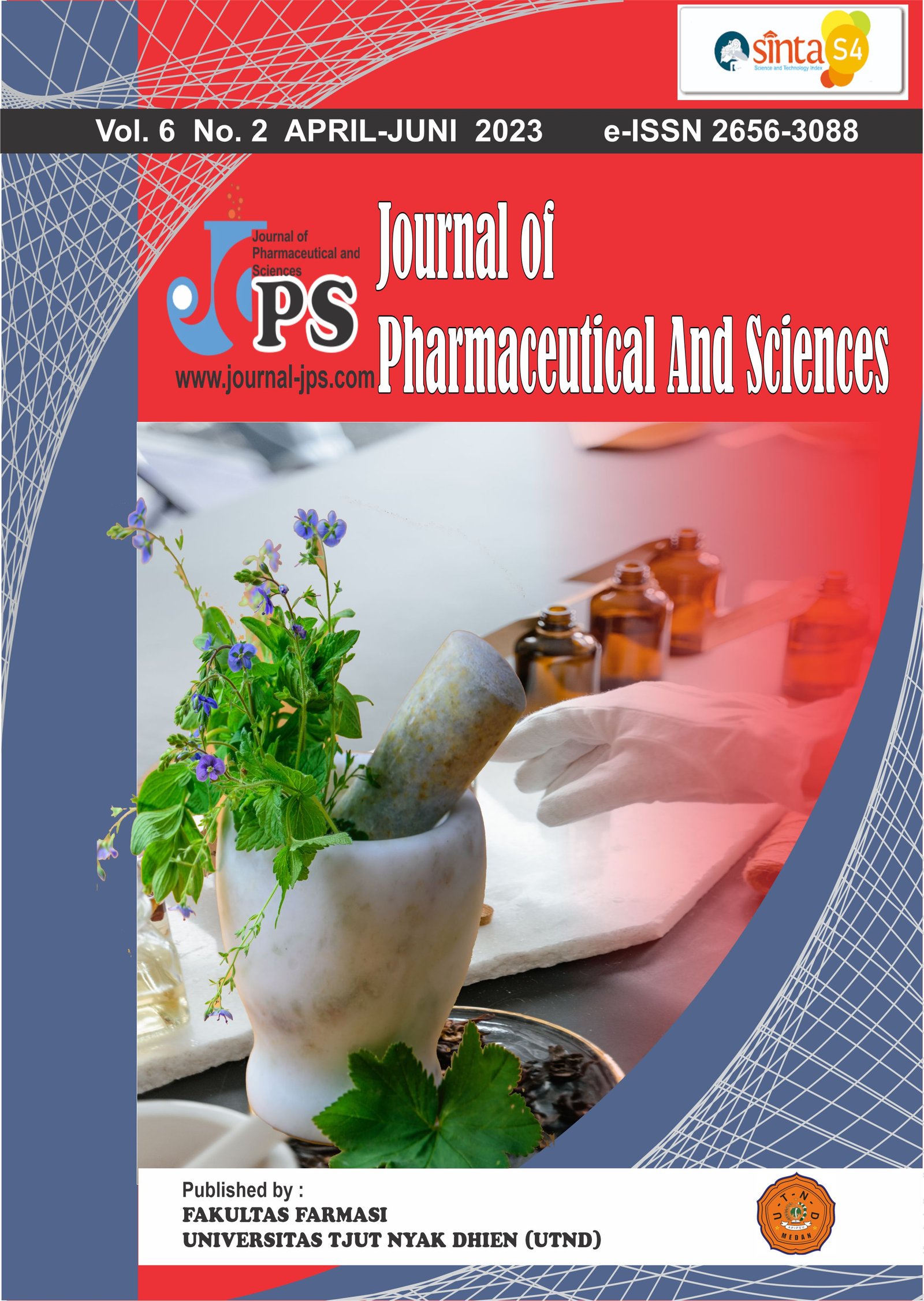Formulation and Effectiveness Test of Sintrong Leaf Ethanol Extract Ointment (Crassocephalum crepidioides (Benth.) S. Moore) Against Burn Healing in Male Guinea Pig (Cavia porcellus)
Main Article Content
Page: 598-606
Abstract
Background; Scar tissue formation due to infectious burns causes delayed maturation of the epidermis. Sintrong contains flavonoids, alkaloids, glycosides, saponins, tannins, and steroids which have anti-inflammatory and antioxidant functions and can protect the body from the harmful effects of free radicals. Preparations with good titration and long exposure times are needed to treat burn problems. This study aims to determine the process of making sintrong leaf ointment (Crassocephalum crepidiodes (Benth.) S.Moore) and the effect of treating burns from sintrong leaf extract in an ointment preparation that has been tested on male guinea pigs (Cavia porcellus). Methods; In this study, test methods were used by means of simplicia preparation, characterization, test phytochemical screening, extraction, formulation and adjustment of ointment preparations to concentrations of 0.5%, 1% and 1.5%, as well as evaluation of ointment tests which included stability tests, sensory tests, homogeneity tests,adhesion, spreadability, pH test, irritation test and efficacy test of ointment preparations. The results obtained from the characteristic examination indicate that the simplicia of the sintrong leaf has fulfilled the requirements of the characteristic test for simplicia. Result; The results of the phytochemical test showed that the positive sintrong leaves contained alkaloids, flavonoids, glycosides, saponins, tannins and triterpenes or steroids. The results of the evaluation of the ethanol extract of sintrong leaf ointment for stable results. The best formulation is formula 3 with a concentration of 1.5% with a wound healing diameter of 0.13 cm on the 21st day
Downloads
Article Details

This work is licensed under a Creative Commons Attribution-NonCommercial-ShareAlike 4.0 International License.
References
Adjatin, A., Dansi, A., Badoussi, E., Loko, Y. L., Dansi, M., Azokpota, P., Gbaguidi, F., Ahissou, H., Akoegninou, A., Akpagana, K., and Sanni, A. (2013). Phytochemical screening and toxicity studies of Crassocephalum rubens (juss, ex Jack.) S. Moore and Crassocephalum crepidioides (Benth) S. Moore consumed as vegetable in Benin. International Journal of Current Biological and chemical sciences, 2 (8): 1-13.
Anggraeni, L., dan Bratadiredja, M. A. (2018). Review Artikel: Tanaman Obat yang memiliki aktivitas terhadap luka bakar. Farmaka, 16(2), 51-59.
Anugerah, R. D., Taurina, W., dan Andrie, M. (2022). Uji Aktivitas Antioksidan Sediaan Salep Ikan Gabus (Channa Striata) Kombinasi Vitamin C Dan Madu Kelulut (Heterotrigona Itama). Journal Syifa Sciences Dan Clinical Research, 4(3), 533-542.
Church, D., Elsayed, S., Reid, O., Winston, B., Lindsay, R., (2006). Burn Wound Infection. Clinical Microbiology Reviews, 19(2), 403-434.
Dhego, A. P., Susanti, L., dan Wibawa D. A. A. (2017) "Uji Aktivitas Antibakteri Salep Ekstrak Kulit Batang Kesambi (Schleichera oleosa Merr) terhadap Staphylococcus aureus ATCC 25923 yang Diinfeksikan pada Kelinci", Biomedika. 10(2), 11-17.
Elsie, B. H dan M.S. Dhanarajan. (2010). Evaluation of Antimicrobial Activity and Phytochemical Screening of Gelidium acerosa. Journal of pharmaceutical sciences and research, 2(11), 704
Gomez, R., Murray., C.K., Hospenthal, D.R., Cancio, L.C., Renz, E.M., Holcomb, J.B., (2009). Causes of Mortality by Autopsy Findings of Combat Casualties and Civilian Patients Admitted to a Burn Unit. Journal of the American College of Surgeon,208(3), 348-354.
Izzati, U. Z. (2015). Efektivitas Penyembuhan Luka Bakar Salep Ekstrak Etanol Daun Senggani (Melastoma Malabathricum L.) Pada Tikus (Rattus Norvegicus) Jantan Galur Wistar. Jurnal Mahasiswa Farmasi Fakultas Kedokteran UNTAN, 3(1).
Jacob, J. M., Oematan, A. B., dan Maakh, Y. F. (2022). Uji Karakteristik Sedaiaan Salep Ekstrak Etanol Buah Makasar (Brucea Javanica (L) Merr) Sebagai Kandidat Salep Untuk Luka Incisi Dan Luka Diabetes. Jurnal Kajian Veteriner, 10(1), 38-50.
Kawarnidi, T., Septiarini, A. D., dan Wardani, T. S. (2022). Formulasi dan evaluasi salep ekstrak daun ketepeng cina (cassia alata L. ) dengan basis vaselin album dan cera alba terhadap jamur candida albicans. Jurnal farmasi dan kesehatan, 2(1), 51-59.
Lisnawati, L., Taurina, W., dan Andrie, M. (2022). Formulasi salep ekstrak ikan gabus (channa striata) dan madu kelulut (heterotrigona itama) sebagai antioksidan. Journal syifa sciences and clinical research, 4(3), 523-532.
Maimunah, S., Pratama, H. A., dan Mayasari, U.(2020). Uji Aktivitas Antibakteri Ekstrak Daun Sintrong (Crassocephalum Crepidiodies) Terhadap Bakteri Staphylococcus Ureus. Jurnal Pembelajaran Dan Biologi Nukleus, 6(1), 103-111.
Rosyidulldab, M., Nasution, T. H., Dan Andarini, S. (2013). Pengaruh Ekstrak Daun Kersen (Muntingia Calabura) Terhadap Derajat Eritema Pada Proses Inflamasi Marmut (Cavia porcellus) Dengan Luka Bakar Derajat II Dangkal. Jurnal Ilmu Keperawatan: Journal Of Nursing Science, 1(2), 157-161.
Simanungkalit,E. R., Duniaji, A. S., Dan Ekawati, I. G. A. (2020). Kandungan Flavonoid Dan Aktivitas Antibakteri Ekstrak Etanol Daun Sintrong (Crassocephalum Crepidiodes) Terhadap Bakteri Bacillus Cereus. Jurnal Ilmu Dan Tekhnologi Pangan, 9(2), 202-210.
Waladani,B., Ernawati, E., Dan Surwaryo, P. A. W. (2021). Peningkatan Dan Keterampilan Kader Kesehatan Masyarakat Dalam Pertolongan Pertama Dengan Kasus Luka Bakar. Jurnal Peduli Masyarakat, 3(2), 185-192.
Wink, M. (2003). Evolution of Secondary Metabolisme from an Ecological and Molecular Phylogenetic Perpective, Phytochemistry 64(1) : 3-19.





